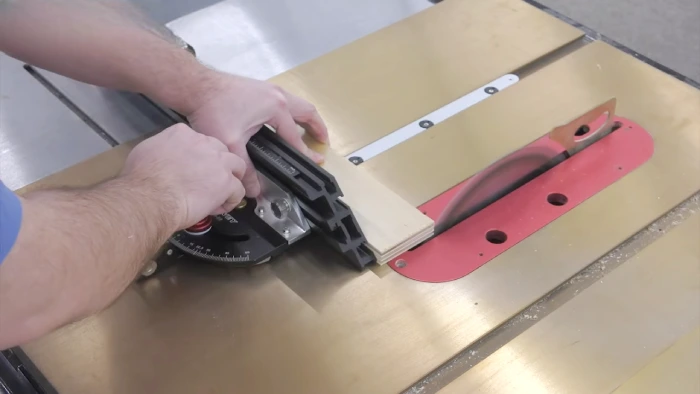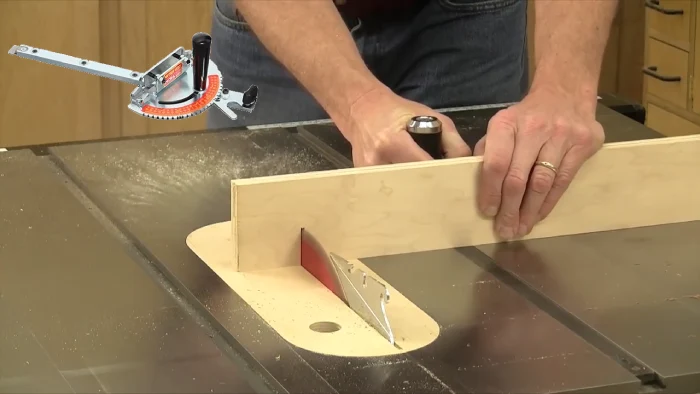WoodenuKnow.com is a participant in the Amazon Services LLC Associates Program, an affiliate advertising program designed to provide a means for sites to earn advertising fees by advertising and linking to Amazon.com and may earn from qualifying purchases.
Crafting a woodcut masterpiece requires precise tools and techniques. Equip yourself with the invaluable combination of table saw and miter gauge, so you can make smooth angled cuts with perfect accuracy. Now you might wonder how to use a miter gauge on a table saw.
An attachable miter gauge is a must to pull off the perfect cut. Find one that fits your table saw and complements its T-slots for optimal performance. Then adjust to get exactly the angle you need before adjusting the fence distance as per your needs. Once you’ve done that, it’s time to create some magic.
Hence, if you want to learn all these steps more concisely, you should read this. While reading this post, ensure you’re putting your 100% concentration into it. Otherwise, you won’t benefit.
How to Use Miter Gauge on Table Saw: Easy Steps
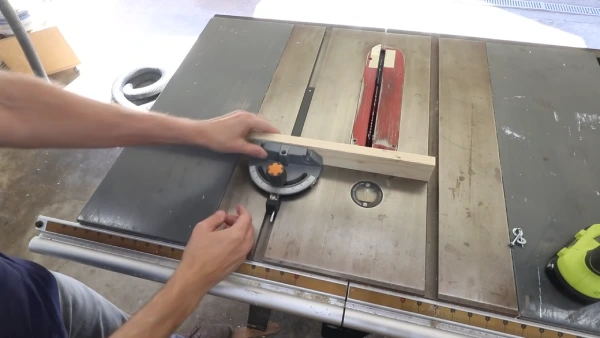
Using a miter gauge on a table saw is essential to creating precise and accurate cuts. You can achieve accurate and efficient results with less effort and time with the right setup. When you use a miter gauge on a table saw, here’s what you need to do:
Step 01: Attach the Miter Gauge to the Table Saw
A miter gauge on a table saw must first be attached securely and adequately to the saw. To do this, ensure the saw is turned off and unplugged before starting. Then, slide the miter gauge into the miter slot on the front of the table saw.
This is usually found near the blade and has a slightly larger opening than other grooves on the table surface. Once it is in place, tighten up the locking mechanism on either side or at both ends of the miter gauge. This will ensure that it does not become loose when in use.
Step 02: Adjust the Miter Gauge Angle
Once the miter gauge is securely attached to your table saw, you can begin adjusting its angle according to your desired cut. Start by loosening up the locking mechanism so that you can pivot it. Then, align it with an angle guide or protractor, depending on the cut you want.
For example, if you need to make an angled cut along a piece of wood, then adjust your miter gauge accordingly until you reach your desired angle. Finally, once it is positioned correctly, tighten up the locking mechanism once again so that there will be no movement during operation.
Step 03: Set The Fence Distance
The essential step in using a miter gauge is setting up its fence distance from the blade of your table saw. To do this accurately and safely, adjust your fence on top of your table saw to align with where you want your cut to occur.
Once in place, measure out from one side of your blade to one side of your fence using either a tape measure or ruler for accuracy. This will ensure that both sides are even before cutting begins.
After double-checking all measurements and angles have been set correctly and precisely as desired, you are now ready to begin cutting with your new setup.
Step 04: Test the Miter Gauge
When using a miter gauge on a table saw, it is crucial to test the accuracy of the gauge before making any cuts. This is done by turning on the table saw and then making a test cut.
The resulting cut should be checked for accuracy and if it does not meet expectations, adjustments should be made to either the angle or the fence distance until desired results are achieved. After each adjustment, another test cut should be made to ensure that it meets expectations.
Step 05: Make Your Cut
Once the miter gauge has been tested and adjusted as needed, it is now time to make your cut. Before doing so, it is crucial to ensure that all necessary safety measures are taken, including wearing personal protective equipment and ensuring that all guards are in place.
Also, when turning on the table saw for this cut, wait for the blade to come to a complete stop before removing any pieces. Doing so will help avoid injury and ensure that you get accurate results with your cuts.
How Do You Cut a 45 Degree Miter on a Table Saw?
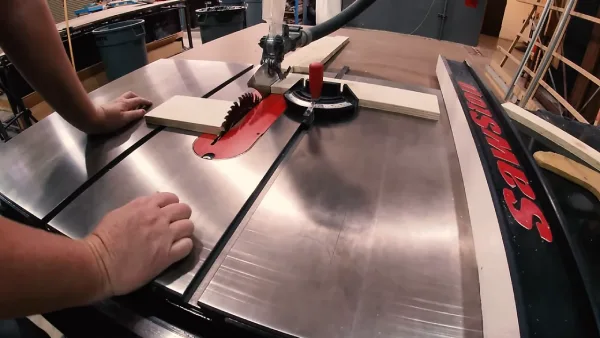
Cutting a 45-degree miter on a table saw is one of the most common woodworking tasks. For starters, you will want to make sure that the blade height is set correctly for the type of material being cut.
The next step is to adjust the miter gauge to a 45-degree angle and secure it in place. Then, position the wood against the miter gauge and ensure it is flush with no gaps in between. It’s important to remember not to rush this process, as it can lead to inaccurate cuts.
Once everything is properly set up, turn on the saw and wait until it reaches full speed before slowly pushing the wood forward. A push stick should be used to keep your hands away from the blade at all times.
After finishing the cuts, turn off the saw and wait for it to come to an absolute stop before checking if everything has been accurately cut or making any additional cuts. If needed, make any necessary adjustments before continuing with your work.
Finally, always use appropriate safety gear when working with power tools such as table saws because they can be dangerous if misused or without precautions.
This includes wearing gloves and eye protection when operating a table saw and adhering to all manufacturer instructions when setting it up or using it.
Can You Use the Miter Gauge for Rip Cutting On a Table Saw?
Using the miter gauge on a table saw for rip cutting is not recommended due to its inherent safety risks and lack of accuracy. It is important to differentiate between a miter gauge and a rip fence, as each tool serves a specific purpose.
A miter gauge is designed for crosscutting operations, while a rip fence is designed specifically for making rip cuts. Since the miter gauge does not offer secure support for the workpiece during ripping, it can lead to inaccurate cuts or even kickback of the workpiece.
This can be dangerous, leading to potential injury or worse. In contrast, a rip fence provides secure support for the workpiece, allowing for greater control during ripping operations.
Before using the rip fence, it must be adjusted parallel to the blade and then coupled with either a push stick or push the block to guide the workpiece through the cut safely.
What’s the Reliable Way to Get a Quality Miter Gauge for a Table Saw?
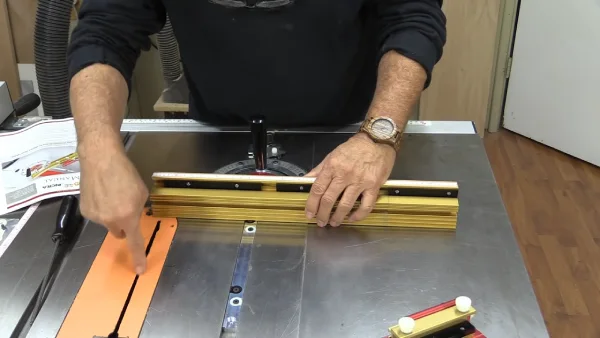
The most reliable way to find a good miter gauge for your table saw is to research, read reviews, check specs and compatibility, consider aftermarket options, ask for recommendations, and test before you buy.
Researching can help you understand a miter gauge for a table saw that fits your needs. Taking the time to read reviews from customers who have purchased the product can provide insight into its performance and reliability. We have already reviewed the best miter gauge for table saw, so you may want to take a look at it.
Checking compatible specs also ensures your new purchase fits your existing table saw setup well. Aftermarket options can be great alternatives to factory-made products. Seeking advice from peers or professionals who have used similar tools helps narrow the selection process.
Lastly, testing a product before making a purchase allows you to experience its features firsthand and ensure it works as expected.
Achieve Woodworking Success with a Miter Gauge on Table Saw
Mastering the use of a miter gauge on a table saw is a vital component for achieving success in the realm of woodworking. And now you know the basics of using a miter gauge on your table saw, it’s time to learn how to use it in practice.
Just securely fasten the miter gauge to the table saw, then fine-tune the angle to meet the requirements of the specific task. Subsequently, the fence distance must be established and examined in conjunction with the miter gauge prior to performing the desired cut.
By executing these steps diligently and adhering to appropriate safety protocols, individuals can operate a miter gauge on their table saw with assurance and proficiency. Ultimately it enhances the quality and precision of their woodworking endeavors.

